徹底搞懂Java多線程(一)
Java多線程
線程的創建
1.繼承Thread
2.實現Runnable
3.實現Callable
使用繼承Thread類來開發多線程的應用程序在設計上是有局限性的,因為Java是單繼承。
繼承Thread類
public class ThreadDemo1 {
// 繼承Thread類 寫法1
static class MyThread extends Thread{
@Override
public void run() {
//要實現的業務代碼
}
}
// 寫法2
Thread thread = new Thread(){
@Override
public void run() {
//要實現的業務代碼
}
};
}
實現Runnable接口
//實現Runnable接口 寫法1
class MyRunnable implements Runnable{
@Override
public void run() {
//要實現的業務代碼
}
}
//實現Runnable接口 寫法2 匿名內部類
class MyRunnable2 {
public static void main(String[] args) {
Thread thread = new Thread(new Runnable() {
@Override
public void run() {
//要實現的業務代碼
}
});
}
}
實現Callable接口(Callable + FutureTask 創建帶有返回值的線程)
package ThreadDeom;
import java.util.concurrent.Callable;
import java.util.concurrent.ExecutionException;
import java.util.concurrent.FutureTask;
/**
* user:ypc;
* date:2021-06-11;
* time: 17:34;
*/
//創建有返回值的線程 Callable + Future
public class ThreadDemo2 {
static class MyCallable implements Callable<Integer>{
@Override
public Integer call() throws Exception {
return 0;
}
}
public static void main(String[] args) throws ExecutionException, InterruptedException {
//創建Callable子對象
MyCallable myCallable = new MyCallable();
//使用FutureTask 接受 Callable
FutureTask<Integer> futureTask = new FutureTask<>(myCallable);
//創建線程並設置任務
Thread thread = new Thread(futureTask);
//啟動線程
thread.start();
//得到線程的執行結果
int num = futureTask.get();
}
}
也可以使用lambda表達式
class ThreadDemo21{
//lambda表達式
Thread thread = new Thread(()-> {
//要實現的業務代碼
});
}
Thread的構造方法

線程常用方法
獲取當前線程的引用、線程的休眠
class Main{
public static void main(String[] args) throws InterruptedException {
Thread.sleep(1000);
//休眠1000毫秒之後打印
System.out.println(Thread.currentThread());
System.out.println(Thread.currentThread().getName());
}
}

package ThreadDeom;
/**
* user:ypc;
* date:2021-06-11;
* time: 18:38;
*/
public class ThreadDemo6 {
public static void main(String[] args) throws InterruptedException {
Thread thread = new Thread(new Runnable() {
@Override
public void run() {
System.out.println("線程的ID:" + Thread.currentThread().getId());
System.out.println("線程的名稱:" + Thread.currentThread().getName());
System.out.println("線程的狀態:" + Thread.currentThread().getState());
try {
Thread.sleep(1000);
} catch (InterruptedException e) {
e.printStackTrace();
}
}
},"線程一");
thread.start();
Thread.sleep(100);
//打印線程的狀態
System.out.println("線程的狀態:"+thread.getState());
System.out.println("線程的優先級:"+thread.getPriority());
System.out.println("線程是否存活:"+thread.isAlive());
System.out.println("線程是否是守護線程:"+thread.isDaemon());
System.out.println("線程是否被打斷:"+thread.isInterrupted());
}
}
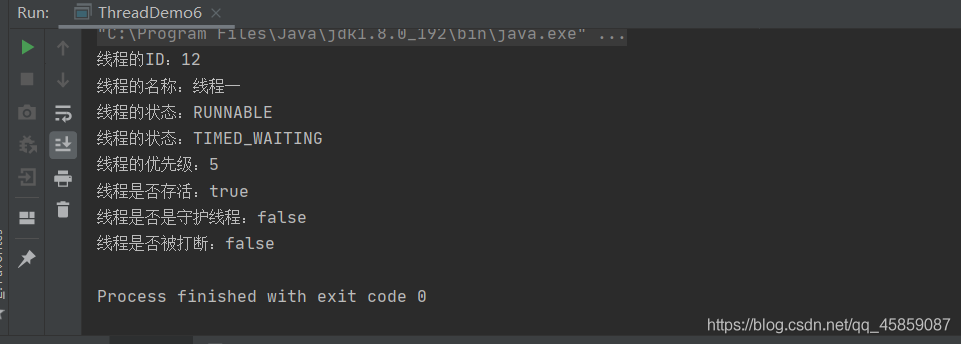
線程的等待
假設有一個坑位,thread1 和 thread2 都要上廁所。一次隻能一個人上,thread2隻能等待thread1使用完才能使用廁所。就可以使用join()方法,等待線程1執行完,thread2在去執行。👇
package ThreadDeom;
/**
* user:ypc;
* date:2021-06-12;
* time: 10:48;
*/
public class ThreadDemo13 {
public static void main(String[] args) throws InterruptedException {
Runnable runnable = new Runnable() {
@Override
public void run() {
System.out.println(Thread.currentThread().getName()+"🚾");
try {
Thread.sleep(1000);
} catch (InterruptedException e) {
e.printStackTrace();
}
System.out.println(Thread.currentThread().getName()+"出來瞭");
}
};
Thread t1 = new Thread(runnable,"thread1");
t1.start();
//t1.join();
Thread t2 = new Thread(runnable,"thread2");
t2.start();
}
}
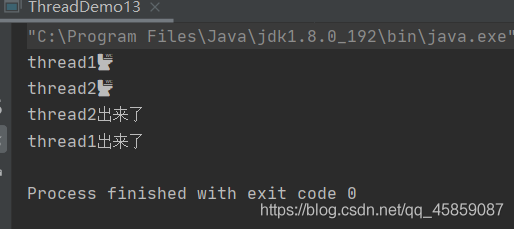
沒有join()顯然是不行的。加上join()之後:
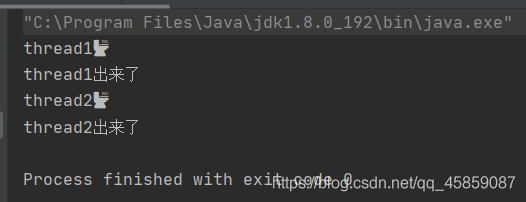
線程的終止
1.自定義實現線程的終止
package ThreadDeom;
/**
* user:ypc;
* date:2021-06-12;
* time: 9:59;
*/
public class ThreadDemo11 {
private static boolean flag = false;
public static void main(String[] args) throws InterruptedException {
Thread thread = new Thread(new Runnable() {
@Override
public void run() {
while (!flag){
System.out.println("我是 : " + Thread.currentThread().getName() + ",我還沒有被interrupted呢");
try {
Thread.sleep(100);
} catch (InterruptedException e) {
e.printStackTrace();
}
}
System.out.println("我是 "+Thread.currentThread().getName()+",我被interrupted瞭");
}
},"thread");
thread.start();
Thread.sleep(300);
flag = true;
}
}

2.使用Thread的interrupted來中斷
package ThreadDeom;
/**
* user:ypc;
* date:2021-06-12;
* time: 9:59;
*/
public class ThreadDemo11 {
// private static boolean flag = false;
public static void main(String[] args) throws InterruptedException {
Thread thread = new Thread(new Runnable() {
@Override
public void run() {
while (!Thread.interrupted()){
System.out.println("我是 : " + Thread.currentThread().getName() + ",我還沒有被interrupted呢");
try {
Thread.sleep(100);
} catch (InterruptedException e) {
// e.printStackTrace();
break;
}
}
System.out.println("我是 "+Thread.currentThread().getName()+",我被interrupted瞭");
}
},"thread");
thread.start();
Thread.sleep(300);
thread.interrupt();
// flag = true;
}
}

3.Thraed.interrupted()方法和Threaed.currentThread().interrupt()的區別
Thread.interrupted()方法第一次接收到終止的狀態後,之後會將狀態復位,Thread.interrupted()是靜態的,是全局的。
Threaed.currentThread().interrupt()隻是普通的方法。
Thraed.interrupted()方法
package ThreadDeom;
/**
* user:ypc;
* date:2021-06-12;
* time: 10:32;
*/
public class ThreadDemo12 {
public static void main(String[] args) throws InterruptedException {
Thread thread = new Thread(() ->{
for (int i = 0; i < 10; i++) {
System.out.println(Thread.interrupted());
}
});
thread.start();
thread.interrupt();
}
}

Threaed.currentThread().interrupt()
package ThreadDeom;
/**
* user:ypc;
* date:2021-06-12;
* time: 10:32;
*/
public class ThreadDemo12 {
public static void main(String[] args) throws InterruptedException {
Thread thread = new Thread(() ->{
for (int i = 0; i < 10; i++) {
// System.out.println(Thread.interrupted());
System.out.println(Thread.currentThread().isInterrupted());
}
});
thread.start();
thread.interrupt();
}
}
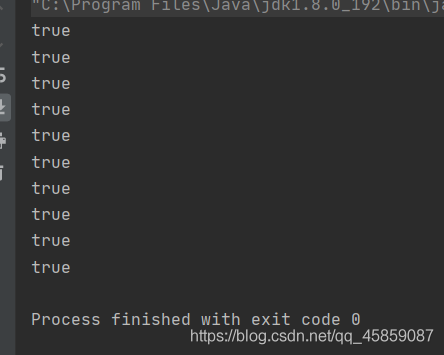
yield()方法
讓出CPU的執行權
package ThreadDeom;
/**
* user:ypc;
* date:2021-06-12;
* time: 11:47;
*/
public class ThreadDemo15 {
public static void main(String[] args) {
Thread thread1 = new Thread(() -> {
for (int i = 0; i < 100; i++) {
Thread.yield();
System.out.println("thread1");
}
});
thread1.start();
Thread thread2 = new Thread(() -> {
for (int i = 0; i < 100; i++) {
System.out.println("thread2");
}
});
thread2.start();
}
}
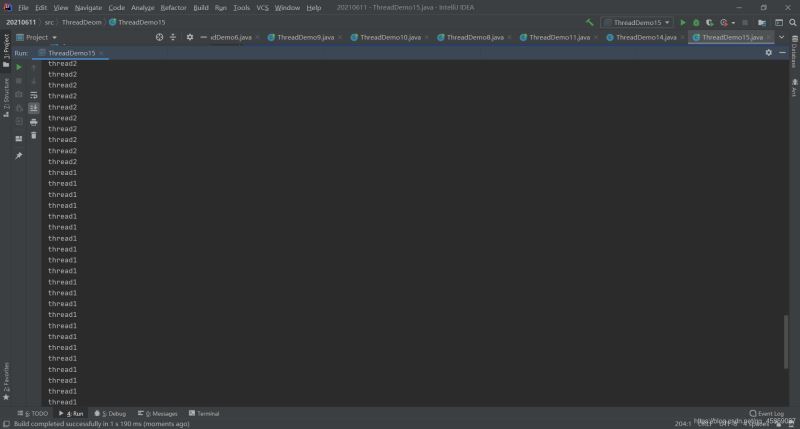
線程的狀態

打印出線程的所有的狀態,所有的線程的狀態都在枚舉中。👇
package ThreadDeom;
/**
* user:ypc;
* date:2021-06-12;
* time: 11:06;
*/
public class ThreadDemo14 {
public static void main(String[] args) {
for (Thread.State state: Thread.State.values()) {
System.out.println(state);
}
}
}
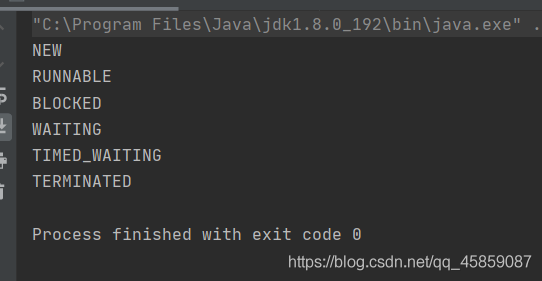
NEW創建瞭線程但是還沒有開始工作RUNNABLE正在Java虛擬機中執行的線程BLOCKED受到阻塞並且正在等待某個監視器的鎖的時候所處的狀態WAITTING無限期的等待另一個線程執行某個特定操作的線程處於這個狀態TIME_WAITTING有具體等待時間的等待TERMINATED已經退出的線程處於這種狀態
package ThreadDeom;
/**
* user:ypc;
* date:2021-06-12;
* time: 11:06;
*/
class TestThreadDemo{
public static void main(String[] args) throws InterruptedException {
Thread thread = new Thread(new Runnable() {
@Override
public void run() {
try {
Thread.sleep(2000);
} catch (InterruptedException e) {
e.printStackTrace();
}
}
});
System.out.println(thread.getState());
thread.start();
System.out.println(thread.getState());
Thread.sleep(100);
System.out.println(thread.getState());
thread.join();
System.out.println(thread.getState());
}
}

線程的優先級
在Java中線程 的優先級分為1 ~ 10 一共十個等級
package ThreadDeom;
/**
* user:ypc;
* date:2021-06-11;
* time: 21:22;
*/
public class ThreadDemo9 {
public static void main(String[] args) {
for (int i = 0; i < 5; i++) {
Thread t1 = new Thread(new Runnable() {
@Override
public void run() {
System.out.println("t1");
}
});
//最大優先級
t1.setPriority(10);
t1.start();
Thread t2 = new Thread(new Runnable() {
@Override
public void run() {
System.out.println("t2");
}
});
//最小優先級
t2.setPriority(1);
t2.start();
Thread t3 = new Thread(new Runnable() {
@Override
public void run() {
System.out.println("t3");
}
});
t3.setPriority(1);
t3.start();
}
}
}
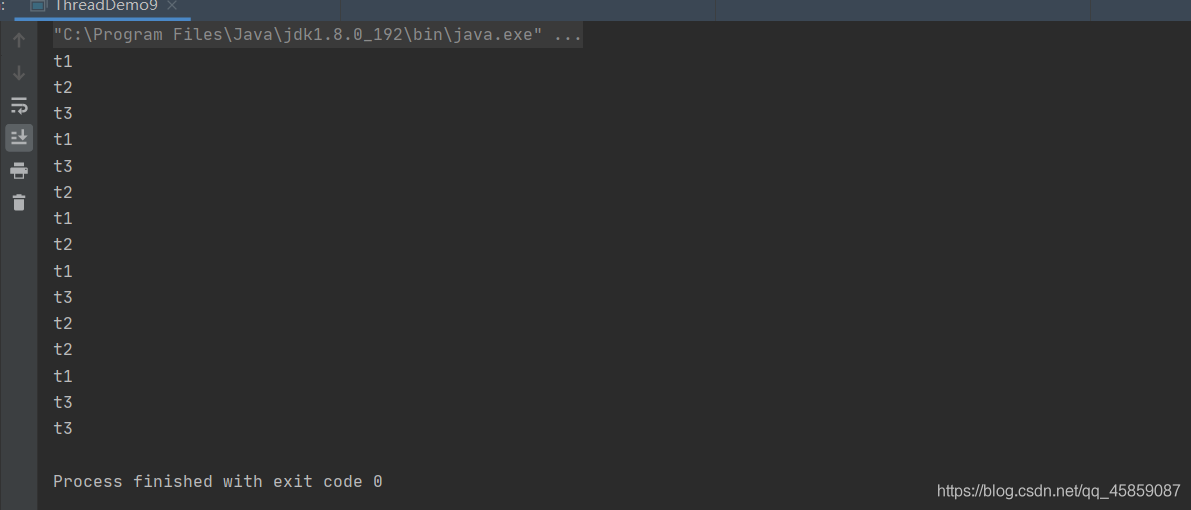
線程的優先級不是絕對的,隻是給程序的建議。
線程之間的優先級具有繼承的特性,如果A線程啟動瞭B線程,那麼B的線程的優先級與A是一樣的。👇
package ThreadDeom;
/**
* user:ypc;
* date:2021-06-11;
* time: 20:46;
*/
class ThreadA extends Thread{
@Override
public void run() {
System.out.println("ThreadA優先級是:" + this.getPriority());
ThreadB threadB = new ThreadB();
threadB.start();
}
}
class ThreadB extends ThreadA{
@Override
public void run() {
System.out.println("ThreadB的優先級是:" + this.getPriority());
}
}
public class ThreadDemo7 {
public static void main(String[] args) {
System.out.println("main線程開始的優先級是:" + Thread.currentThread().getPriority());
System.out.println("main線程結束的優先級是:" + Thread.currentThread().getPriority());
ThreadA threadA = new ThreadA();
threadA.start();
}
}
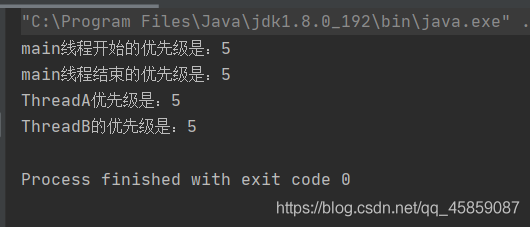
再看👇
package ThreadDeom;
/**
* user:ypc;
* date:2021-06-11;
* time: 20:46;
*/
class ThreadA extends Thread{
@Override
public void run() {
System.out.println("ThreadA優先級是:" + this.getPriority());
ThreadB threadB = new ThreadB();
threadB.start();
}
}
class ThreadB extends ThreadA{
@Override
public void run() {
System.out.println("ThreadB的優先級是:" + this.getPriority());
}
}
public class ThreadDemo7 {
public static void main(String[] args) {
System.out.println("main線程開始的優先級是:" + Thread.currentThread().getPriority());
Thread.currentThread().setPriority(9);
System.out.println("main線程結束的優先級是:" + Thread.currentThread().getPriority());
ThreadA threadA = new ThreadA();
threadA.start();
}
}
結果為👇
守護線程
Java中有兩種線程:一種是用戶線程,一種就是守護線程。
什麼是守護線程?守護線程是一種特殊的線程,當進程中不存在用戶線程的時候,守護線程就會自動銷毀。典型的守護線程就是垃圾回收線程,當進程中沒有瞭非守護線程,則垃圾回收線程也就沒有存在的必要瞭。
Daemon線程的作用就是為其他線程的運行提供便利的。👇
package ThreadDeom;
/**
* user:ypc;
* date:2021-06-11;
* time: 21:06;
*/
public class ThreadDemo8 {
static private int i = 0;
public static void main(String[] args) throws InterruptedException {
Thread thread = new Thread(new Runnable() {
@Override
public void run() {
while (true){
i++;
System.out.println(i);
try {
Thread.sleep(1000);
} catch (InterruptedException e) {
e.printStackTrace();
}
}
}
});
//設置守護線程
thread.setDaemon(true);
thread.start();
Thread.sleep(5000);
System.out.println("我是守護線程thread 當用戶線程執行完成後 我也就銷毀瞭😭哭瞭");
}
}

註意:守護線程的設置必須放在start()之前,否則就會報錯。
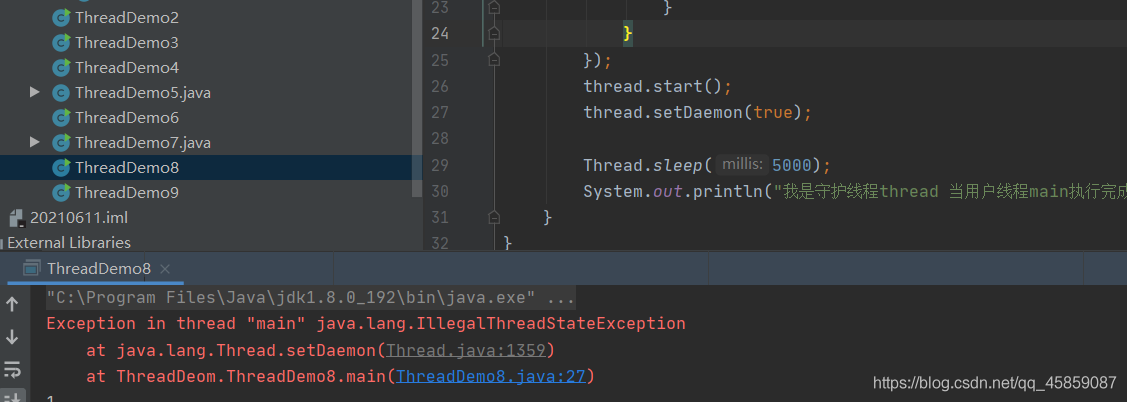
在守護線程中創建的線程默認也是守護線程。
package ThreadDeom;
/**
* user:ypc;
* date:2021-06-12;
* time: 9:35;
*/
public class ThreadDemo10 {
public static void main(String[] args) {
Thread thread1 = new Thread(()->{
Thread thread2 = new Thread(() -> {
},"thread2");
System.out.println("thread2是守護線程嗎?:" + thread2.isDaemon());
},"thread1");
System.out.println("thread1是守護線程嗎?:" + thread1.isDaemon());
//thread1.setDaemon(true);
thread1.start();
// System.out.println("thread1是守護線程嗎?:" + thread1.isDaemon());
}
}

再看👇
package ThreadDeom;
/**
* user:ypc;
* date:2021-06-12;
* time: 9:35;
*/
public class ThreadDemo10 {
public static void main(String[] args) {
Thread thread1 = new Thread(()->{
Thread thread2 = new Thread(() -> {
},"thread2");
System.out.println("thread2是守護線程嗎?:" + thread2.isDaemon());
},"thread1");
System.out.println("thread1是守護線程嗎?:" + thread1.isDaemon());
thread1.setDaemon(true);
thread1.start();
System.out.println("thread1是守護線程嗎?:" + thread1.isDaemon());
}
}

線程組
為瞭便於對某些具有相同功能的線程進行管理,可以把這些線程歸屬到同一個線程組中,線程組中既可以有線程對象,也可以有線程組,組中也可以有線程。使用線程模擬賽跑
public class ThreadDemo5 {
//線程模擬賽跑(未使用線程分組)
public static void main(String[] args) {
Thread t1 = new Thread(new Runnable() {
@Override
public void run() {
try {
Thread.sleep(1000);
} catch (InterruptedException e) {
e.printStackTrace();
}
System.out.println(Thread.currentThread().getName() + "到達瞭終點");
}
}, "選手一");
Thread t2 = new Thread(new Runnable() {
@Override
public void run() {
try {
Thread.sleep(1200);
} catch (InterruptedException e) {
e.printStackTrace();
}
System.out.println(Thread.currentThread().getName() + "到達瞭終點");
}
}, "選手二");
t1.start();
t2.start();
System.out.println("所有選手到達瞭終點");
}
}
運行結果:

不符合預期效果,就可以使用線程組來實現
package ThreadDeom;
/**
* user:ypc;
* date:2021-06-11;
* time: 18:24;
*/
class ThreadGroup1 {
//線程分組模擬賽跑
public static void main(String[] args) {
ThreadGroup threadGroup = new ThreadGroup("Group");
Thread t1 = new Thread(threadGroup, new Runnable() {
@Override
public void run() {
try {
Thread.sleep(1000);
} catch (InterruptedException e) {
e.printStackTrace();
}
System.out.println("選手一到達瞭終點");
}
});
Thread t2 = new Thread(threadGroup, new Runnable() {
@Override
public void run() {
try {
Thread.sleep(1200);
} catch (InterruptedException e) {
e.printStackTrace();
}
System.out.println("選手二到達瞭終點");
}
});
t2.start();
t1.start();
while (threadGroup.activeCount() != 0) {
}
System.out.println("所有選手到達瞭終點");
}
}

線程組常用的方法
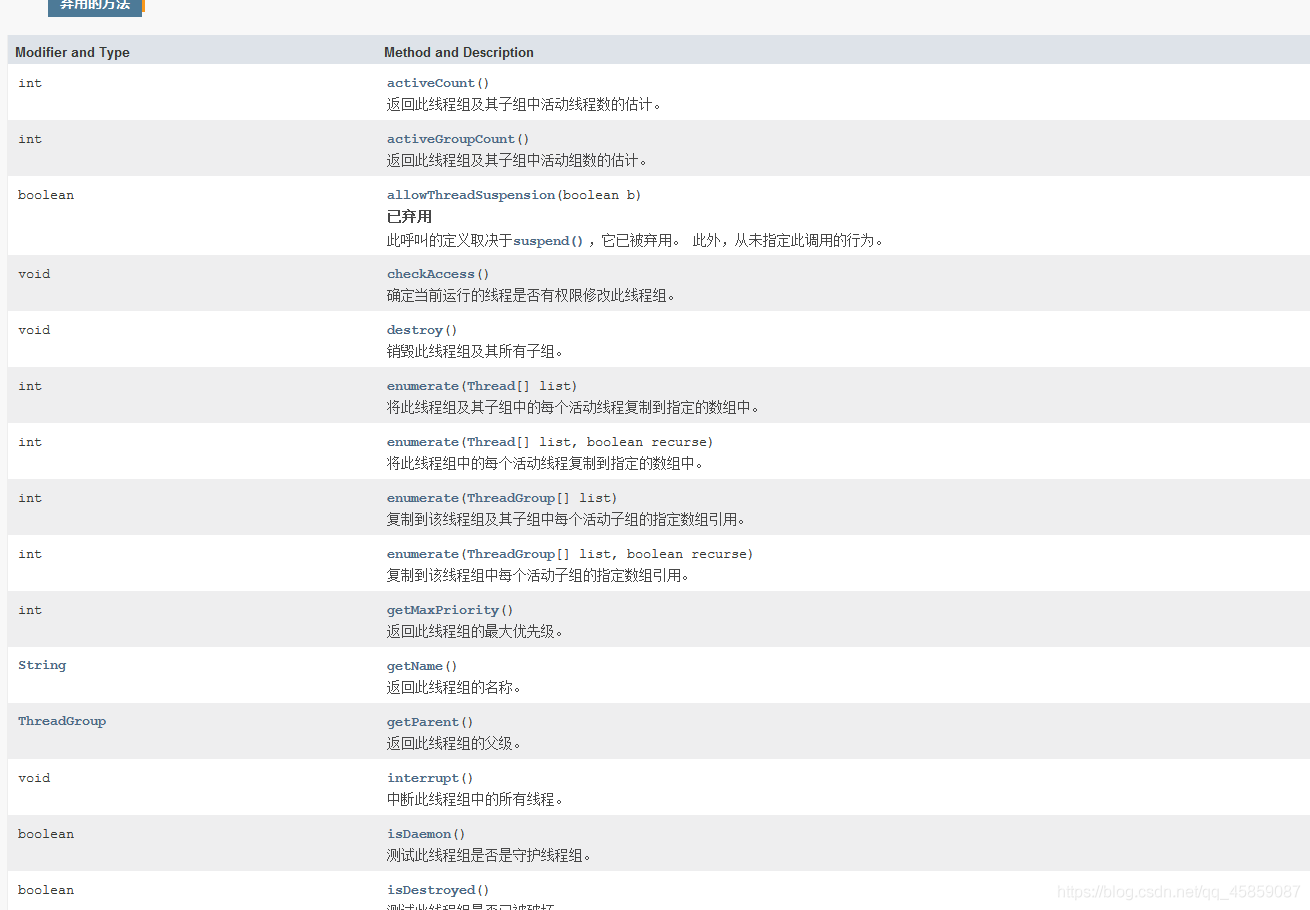
線程安全問題
來看單線程情況下讓count分別自增和自減10000次
package ThreadDeom;
/**
* user:ypc;
* date:2021-06-12;
* time: 12:03;
*/
class Counter {
private static int count = 0;
public void increase(){
for (int i = 0; i < 10000; i++) {
count++;
}
}
public void decrease(){
for (int i = 0; i < 10000; i++) {
count--;
}
}
public int getCount(){
return count;
}
}
public class ThreadDemo16 {
public static void main(String[] args) {
//單線程
Counter counter = new Counter();
counter.increase();
counter.decrease();
System.out.println(counter.getCount());
}
}
結果符合預期

如果想使程序的執行速度快,就可以使用多線程的方式來執行。在來看多線程情況下的問題
public class ThreadDemo16 {
public static void main(String[] args) throws InterruptedException {
//多線程情況下
Counter counter = new Counter();
Thread thread1 = new Thread(()->{
counter.decrease();
});
Thread thread2 = new Thread(()->{
counter.increase();
});
thread1.start();
thread2.start();
thread1.join();
thread2.join();
System.out.println(counter.getCount());
/*
//單線程
Counter counter = new Counter();
counter.increase();
counter.decrease();
System.out.println(counter.getCount());
*/
}
}
執行結果:

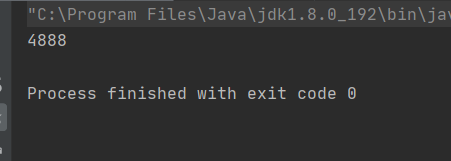

每次的執行結果是不一樣的。這就是多線程的不安全問題
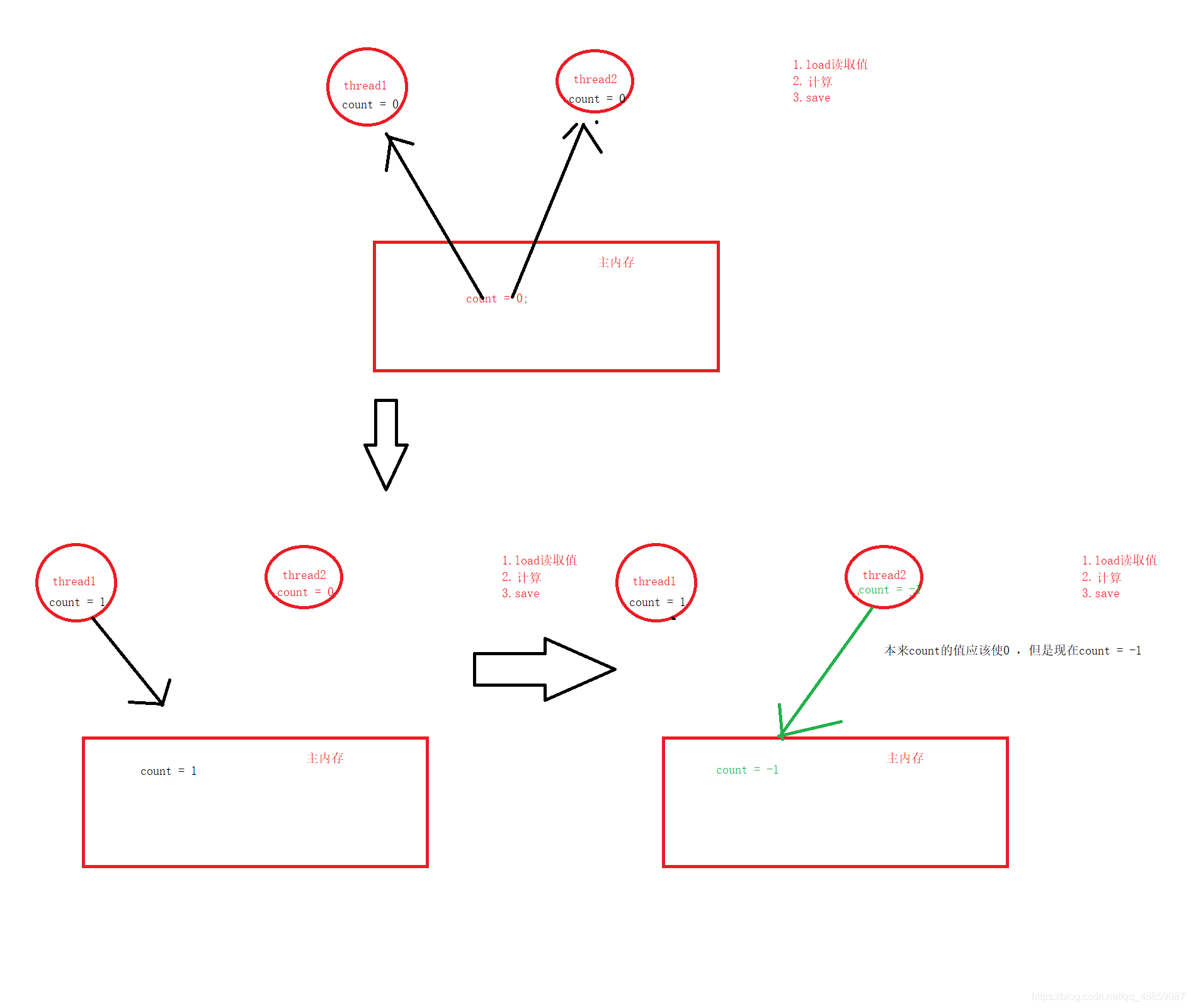
預期的結果是0,但結果卻不是。線程不安全問題的原因:
- 1.CPU的搶占式執行
- 2.多個線程共同操作一個變量
- 3.內存可見性
- 4.原子性問題
- 5.編譯器優化(指令重排)
多個線程操作同一個變量
如果多個線程操作的不是一個變量,就不會發生線程的不安全問題,可以將上面的代碼修改如下:👇
public class ThreadDemo16 {
static int res1 = 0;
static int res2 = 0;
public static void main(String[] args) throws InterruptedException {
Counter counter = new Counter();
Thread thread1 = new Thread(new Runnable() {
@Override
public void run() {
res1 = counter.getCount();
}
});
Thread thread2 = new Thread(new Runnable() {
@Override
public void run() {
res2 = counter.getCount();
}
});
System.out.println(res1 + res2);
/*
//多線程情況下
Counter counter = new Counter();
Thread thread1 = new Thread(()->{
counter.decrease();
});
Thread thread2 = new Thread(()->{
counter.increase();
});
thread1.start();
thread2.start();
thread1.join();
thread2.join();
System.out.println(counter.getCount());
*/
/*
//單線程
Counter counter = new Counter();
counter.increase();
counter.decrease();
System.out.println(counter.getCount());
*/
}
}
這樣就可以瞭:

內存不可見問題:看下面的代碼,是不是到thread2執行的時候,就會改變num的值,從而終止瞭thread1呢?
package ThreadDeom;
import java.util.Scanner;
/**
* user:ypc;
* date:2021-06-12;
* time: 13:03;
*/
public class ThreadDemo17 {
private static int num = 0;
public static void main(String[] args) {
Thread thread1 = new Thread(new Runnable() {
@Override
public void run() {
while (num == 0){}
}
});
thread1.start();
Thread thread2 = new Thread(new Runnable() {
@Override
public void run() {
Scanner scanner = new Scanner(System.in);
System.out.println("輸入一個數字來終止線程thread1");
num = scanner.nextInt();
}
});
thread2.start();
}
}
結果是不能的:
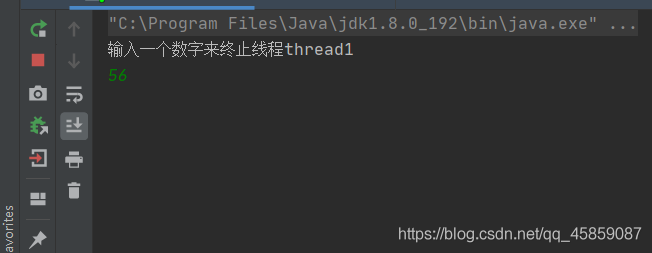
輸入一個數字後回車,並沒有讓thread1的循環結束。這就是內存不可見的問題。
原子性的問題
上面的++和–操作其實是分三步來執行的

假設在第二部的時候,有另外一個線程也來修改值,那麼就會出現臟數據的問題瞭。
所以就會發生線程的不安全問題
編譯器優化編譯器的優化會打亂原本程序的執行順序,就有可能導致線程的不安全問題發生。在單線程不會發生線程的不安全問題,在多線程就可能會不安全。
volatile關鍵字
可以使用volatile關鍵字,這個關鍵字可以解決指令重排和內存不可見的問題。

加上volatile關鍵字之後的運行結果

但是volatile關鍵字不能解決原子性的問題👇:
package ThreadDeom;
/**
* user:ypc;
* date:2021-06-12;
* time: 14:02;
*/
class Counter1 {
private static volatile int count = 0;
public void increase() {
for (int i = 0; i < 10000; i++) {
count++;
}
}
public void decrease() {
for (int i = 0; i < 10000; i++) {
count--;
}
}
public int getCount() {
return count;
}
}
public class ThreadDemo18 {
public static void main(String[] args) throws InterruptedException {
Counter1 counter1 = new Counter1();
Thread thread1 = new Thread(new Runnable() {
@Override
public void run() {
counter1.decrease();
}
});
Thread thread2 = new Thread(() -> {
counter1.increase();
});
thread1.start();
thread2.start();
thread1.join();
thread2.join();
System.out.println(counter1.getCount());
}
}
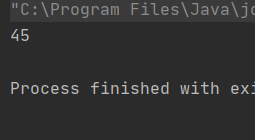

總結
本篇文章就到這裡,希望可以幫到你,也希望您能夠多多關註WalkonNet的其他文章!
